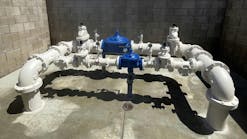Recently, I spoke with Cindy Wallis-Lage, President of Black & Veatch’s water business about the issues facing the U.S. water and wastewater industry today. Black & Veatch’s 2021 Strategic Directions: Water Report had just been released, and the findings were as eye-opening as the events of the last year.
Built from expert analysis of survey responses from more than 200 stakeholders in the U.S. water and wastewater industry, it may not surprise you that aging infrastructure and an aging workforce remain top challenges. This year’s report, however, highlights a few other areas that the industry has struggled with in the last 12 months. For example, now more than ever, intensifying natural disasters highlight the rising impacts of climate change on the resilience of our water systems. The effects of extreme weather have required some agencies to make significant investments in order to stay online.
“When I think of top takeaways [from this report], what I am really pleased at is seeing the admirable adaptability and the agility of these central service workers that show that we have, within the water utility industry, the ability to adapt and the ability to overcome,” Wallis-Lage said.
The global COVID-19 pandemic compounded the pressure on utilities to be resilient in their services and make strategic investments in supply, treatment, conveyance and storage facilities, on top of other challenges.
“Those utilities that have embraced innovation, that have embraced technology — including data analytics, additional water tools, and automation — have been able to use these tools to get their jobs done more effectively and efficiently.”
The pandemic really drove utilities’ drive to operate differently, she said. Some utilities fast-tracked plans to digitize early in 2020, while others, further along in their adoption of digital technology, began looking at other areas of their business that could benefit from data and analytics.
Indeed, the survey results show that utilities will need to realize the value of exploiting data in their operations by using analytics and other technologies to drive better decision-making to optimize and prioritize system investments and drive cost efficiencies.
For those looking for a roadmap to digitalization, author David Johnston discusses the seven steps to digital transformation in this issue. The steps are adapted from the Smart Water Network Forum (SWAN), a global non-profit organization focused on digital transformation in the water and wastewater industry.
“Becoming a digital water utility is a necessity for addressing aging infrastructure and increasing water scarcity, stress on water systems, urbanization and extreme weather events,” Johnston writes.
“The most profound challenge for building a digital utility is that no utility is alike, which means there is no one-size-fits-all solution. Some utilities have smaller budgets, some are more advanced, population sizes vary and distribution systems are unique.”
Though many water utilities are on a journey toward digitization, many factors determine their points of engagement. With planning, all utilities can become digital utilities. Read more on page 10.
In the 10th month of 2021, it seems we are back to traveling, back to in-person events and meetings, and things (as far as the water business goes) are flowing smoothly. I hope that as we enter the cooler part of the year, you and your loved ones stay safe and healthy, and are able to enjoy some autumnal activities, wherever you may find yourself this time of year.
As always, thanks for reading! WW




